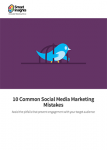In 2017, social media platforms boasted 2.8 billion users across the globe. That equates to about 37 percent penetration, and the numbers continue to grow every year. For marketers who know how to segment their audiences, that’s excellent news.
Social media channels offer the most granular way for marketers to identify real people. They allow marketers to not only know when they’re advertising to males, females, young adults, or retirees, but also to cross-reference basic demographics with profile data, behavior, interests, and users’ social graphs in order to qualify audiences at a level superior to other advertising channels.
The ability to target exactly who you want and to take attributes from your CRM data and consumer preferences specific to how they interact with your brand is a unique advantage of social advertising. For instance, the San Antonio Spurs tested a variety of creatives for Facebook’s link ads to encourage a custom audience of users to purchase tickets. The campaign resulted in a return of 30x what the team spent on ads.
In another case, the online retailer ASOS used dynamic Facebook ads targeted to users who preferred to shop on its mobile app to help increase its audience volume by as much as 35%.
However, segmenting your audience is only half the battle. The rest relies on your ability to define and target your audience members by their stages in the funnel: prospecting new customers, people who have visited your site or have interacted with your brand but have not converted, and existing customers who have histories of shopping with you.
Ever get followed by an ad for a product you’ve already purchased? You see what I mean.
Identifying and Understanding Audiences
For their social ad campaigns to pay off, e-commerce brands need to know their customers and audiences inside and out. At the least, they need to know whether their audiences are mostly male or female; in their 20s or in their 40s; and more enthusiastic about fitness or entertainment, for example.
It’s also essential for brands to know their buyers by email address, number of purchases in the past year, and average basket size. When you can identify your customers and understand their lifestyles and buying habits, you can build look-alike audiences with similar qualities to expand the reach of your acquisition strategy.
But when marketers target all potential customers without considering whether they belong in prospecting or retargeting buckets, they miss out on reaching their most qualified audiences, decreasing the campaign’s likelihood of producing ROI. While brands are growing more sophisticated in segmenting their CRM lists, many still mix all groups into the same audience.
Acquisition, or prospecting, audiences are consumers who have never interacted with your brand. They’re pure-play audiences, and campaigns targeting them should be introductions to the company.
Retargeting audiences typically consist of two sub-buckets: those who have clicked through your ads but haven’t made a purchase and those who have already purchased.
For the first sub-bucket, you’ve prospected them previously and now it’s time for you to deliver a dynamic ad that builds on that past interaction. For consumers who have purchased from your company in the past year or two, you want to drive repeat purchases. For example, the customer who has already bought a pair of shoes from you is more likely to be interested in your newest line of footwear.
Are You Optimizing Right?
Acquisition and retargeting groups are quite different, and the point of audience segmentation is to inform more effective campaign messaging and calls to action; excluding each type of audience from the others helps you drill down and make that message more relevant.
Once you’ve done that, the next step is to get creative with your CRM data. Look at it from different angles; if you sell multiple products, for instance, you might be able to segment your audience by product type and customers’ lifetime values.
Facebook’s technology is especially suited for such a segmentation strategy. It allows you to upload pertinent CRM data and target look-alikes across the entire platform. Including more specific details allows you to further refine your prospecting matches and exclude customers who might match but have already purchased from your brand.
The benefits of segmenting your audience go beyond knowing whom you’re targeting. They include understanding whom you’ve successfully reached and identifying similar consumers who might be ready for introductions to your brand.
3 Strategies for Successful Segmentation
Ready to work on your next campaign? Use these three strategies to ensure you’re successfully segmenting your audience and using your data effectively:
1. Keep a list of all active buyers
Creating a list of active buyers will allow you to exclude them from your acquisition campaigns. These exclusions will continue to grow as your social campaigns become more successful. You can also further segment this list to tailor future retargeting campaigns.
Depending on the product on which your campaign focuses, you might want to reach out to customers who have made a recent purchase. That alone is an opportunity to segment your audience. You might target users who purchase monthly, those who purchased in the past 90 days, or those who purchased in the past six months, for example, with unique offers to activate them in different ways or increase their loyalty.
You can further segment this group into those with a lifetime value in a specific range — $200 to $349, $350 to $499, or $500-plus, for example. Groups with different lifetime values would benefit from more relevant messaging.
2. Get granular with your data
You have the data, so it’s time to dive into the specifics. Your data isn’t beneficial just for segmenting; it also helps you serve better ads and speak to each group more effectively.
People who buy pants, for example, aren’t all buying the same kind of pants. Some buy jeans, others buy khakis, and members of a third group prefer corduroys; some even buy combinations of the three.
Each of these audiences might be very different and have varied lifetime values, so why not treat them as such? The more granular you get with CRM data, the more specifically you can segment your audience and the more relevant you can make the creative ad copy aimed at attracting that audience.
3. Have someone help analyze the data
Find a trusted expert to help you organize and analyze the immense amount of CRM data you’ve acquired. You can only come up with so many ways to get creative. If you don’t know the data cold or can think about it in only certain ways, you’ll benefit from an expert’s opinion on further breaking down groups.
The more products your brand sells, the more important it is to look at CRM data from several different viewpoints. Each product and combination of products creates an opportunity to segment your audience. You can take advantage of more of those opportunities if you have an experienced pair of eyes helping you identify them.
Paid social marketing is a popular tactic, but many brands don’t see the results they expect because they fail to segment their audiences properly. CRM data and social media technology offer all the tools you need in order to be successful — and with these three strategies, you can make the most of them in your next campaign.

